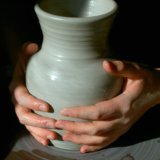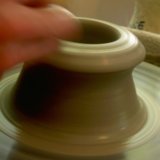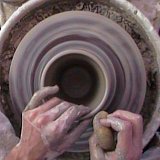|
Raku KilnsFiring, Burners, Temperatures, and Building Kilns from PlansHave designs for building raku kilns or plans to find a kiln for sale? Learn about raku burners, safety, temperatures and supplies here. Smoke, crackle, and iridescent glazes are just part of what you get when firing a raku ceramic kiln. This exciting method of firing pottery is also one of the easiest and most satisfying techniques. While most gas, wood, and electric kilns fire and cool over several days, raku pottery fires in hours. Raku also combines some of the techniques used in the other firing methods to produce it's unique, nearly instant results. How a Raku Ceramic Kiln WorksRaku firing is done in three parts. 1) First, the pottery is bisque fired in an electric kiln, just like almost every other firing technique. 2) Second, the pottery is glazed and fired in a simple gas kiln using a raku kiln burner such as a venturi burner. 3) Finally, when the pottery is at it's hottest temperature, the red hot ware is pulled out of the kiln and enclosed in a garbage can filled with combustible material such as newspaper or leaves. Why the garbage can? The garbage can serves as a reduction chamber for the pottery. It is usually filled with a light, dry material such as newspaper, leaves, or straw. The red hot pottery ignites the material, which in turn burns up all of the oxygen in the closed garbage can. The flame desperately searching for oxygen, pulls oxygen out of the surfaces of the pottery, while replacing it with carbon. The result is that most unglazed surfaces in raku turn a smoky gray or black. The glazed surfaces, on the other hand, react with the carbon to create beautiful, spontaneous effects in the glaze. The Ups and Downs of RakuThe upside of raku pottery is the bright, exciting, spontaneous glaze effects it produces. The other upside is how quickly a pot can go from boring bisque to brilliantly finished pot. The downside of raku is that it is not very functional. The rapid heating and cooling of the clay causes it to develop a spider web of cracks. These cracks create appealing visual effects, but they take away from the pot's ability to hold water. The other downside is the amount of smoke the process produces. This can be more or less of an issue depending on your neighbors. Building a Raku KilnIf you'd rather not search for a complete raku kit for sale you can get plans to build your own kiln. They require relatively few kiln parts and raku kiln supplies are fairly inexpensive. You basically need a platform of fire brick, a metal cage wrapped in ceramic fiber blanket (be sure to use the right materials here), and a gas kiln burner. You can put this together yourself or buy a tried and true design in a kit from a kiln manufacturer along with plans for building it. Safety Using and Building Raku KilnsThis does not include all of the safety advice you will need but here is an overview of some safety considerations. Please do additional research and check with your kiln supplies manufacturer for more safety information. Be careful when using ceramic fiber blanket material as it can be harmful to your lungs and eyes. Also remember you are handling clay pots at around 1800-1900 degrees around open gas flames and the risks of starting a fire are high. Finally, avoid using galvanized material for the kiln body as the vapors can be very harmful to breathe.
Thanks for learning about the raku ceramic kiln, and Happy Potting.
Return From Raku Kilns |
Learn Right
The First Time
Pottery on the Wheel for Beginners
is a complete beginners guide
to learning pottery.
It will
take you from
never having touched clay
to creating finished pottery
you can use every day.
Also read it on Kindle
Featured Pages
Choose Your Wheel
Thank you so much for
visiting my website!
Discover How I Made It!
Happy Potting!
- Steve










